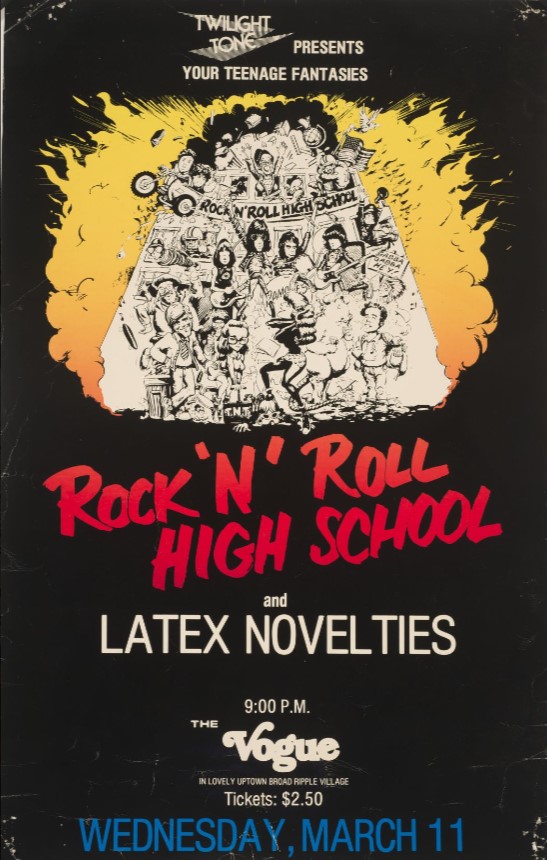A landmark for the neighborhood, located at 6259 North College Avenue, the Vogue opened in 1938 as an upscale movie theater. Carl W. Niesse, who managed three other Indianapolis theaters (the Ambassador, the Alamo, and the Cozy), built the Vogue. Hollywood film stars Mary Pickford and Buddy Rogers suggested its name.

Niesse masterfully built anticipation for the opening of the Vogue during its construction. While he was traveling through town with the Cole Brothers Circus, cowboy star Ken Maynard added a brick as a cornerstone during a public ceremony. Twenty-eight Hollywood stars, including Fort Wayne native Carole Lombard and her then-boyfriend Clark Gable who also later attended the theater’s opening, presented Niesse with an autographed bronze star, which he placed in the sidewalk in front of the building.
The Vogue opened on June 18, 1938, screening College Swing, starring Martha Raye and Bob Hope. Admission was just 25 cents for adults and 15 cents for children. The 800-seat theater was modern with every comfort. It not only included two box offices, a women’s lounge, a men’s smoking room, and a large parking lot but also was one of the first movie theaters to have air-conditioning. The theater thrived for over a decade.

In 1954, Niesse decided it was time to sell the Vogue because of slowing ticket sales, a reflection of a national phenomenon that accompanied the advent of television and the growing popularity of drive-in theaters. It officially closed on October 30 of that year. Locally-owned, Helen Realty Company purchased and renovated the venue with a redecorated lobby, a new concessions area, new seats and carpets, and updated projection equipment. The Vogue reopened on November 24, 1954, with a showing of Sabrina, starring Audrey Hepburn, Humphrey Bogart, and William Holden.
The Vogue hit another downturn in ticket sales by 1970. In October 1971, the theater began showing second-run films at reduced ticket prices in the hope of boosting attendance. Two years later, local businessmen Robert Wilder, Frederich Klipsch, and Charles Lanham took over the theater’s operation. They planned to show first-run films without increasing the prices charged when it operated as a second-run theater with the idea that they could attract large numbers of patrons. The Vogue continued to struggle. By 1974, the owners resorted to showing X-rated films to keep the doors open.
In 1977, John Ross and Doug Turnbull bought the Vogue and brought it back to life by turning it into a music venue. They marked the shift with a bit of humor by putting “Porn Free” on the marquee, a spin on the popular 1966 film and a mid-1970s television series Born Free. The reopening of the Vogue took place on New Year’s Eve, 1977.
The Vogue, as a music venue, found renewed success by featuring national and local bands. Ross and Turnbull also experimented with other types of performances, including hosting World Wrestling Association heavyweight champion for a night of professional wrestling.

In May 1986, Steve Ross and his partner Dennis Burris took over the Vogue. They continued to feature both national and local artists but with more focus on emerging musicians. Wanting to add a nightclub focus to the Vogue, Ross and Burris remodeled the venue in September 1993, adding two bars and a deli, installing 100,000 watts of lighting and sound systems, and quadrupling the size of the dance floor. By 1996, they added regular dance nights and “Retro Rewind” nights to the venue’s schedule to accommodate a changing music and nightclub scene in Indianapolis.
Steve Ross became the sole owner of the Vogue in 2000. For nearly two decades, he kept the venue going with a mix of live music and dance nights. Under the direction of both John and Steve Ross, the Vogue hosted many local bands as well as nationally known acts, such as Johnny Cash, Joan Jett, John Mellencamp, Frank Zappa, the Red Hot Chili Peppers, and Willie Nelson.
In 2019, Ross sold the Vogue to Forty5, run by local entrepreneurs Eric Tobias, Scott Kraege, and Andrew Davis. The new owners not only continued to bring touring acts, DJ dance parties, and tribute acts to the venue but also committed to community development in Broad Ripple.

Help improve this entry
Contribute information, offer corrections, suggest images.
You can also recommend new entries related to this topic.